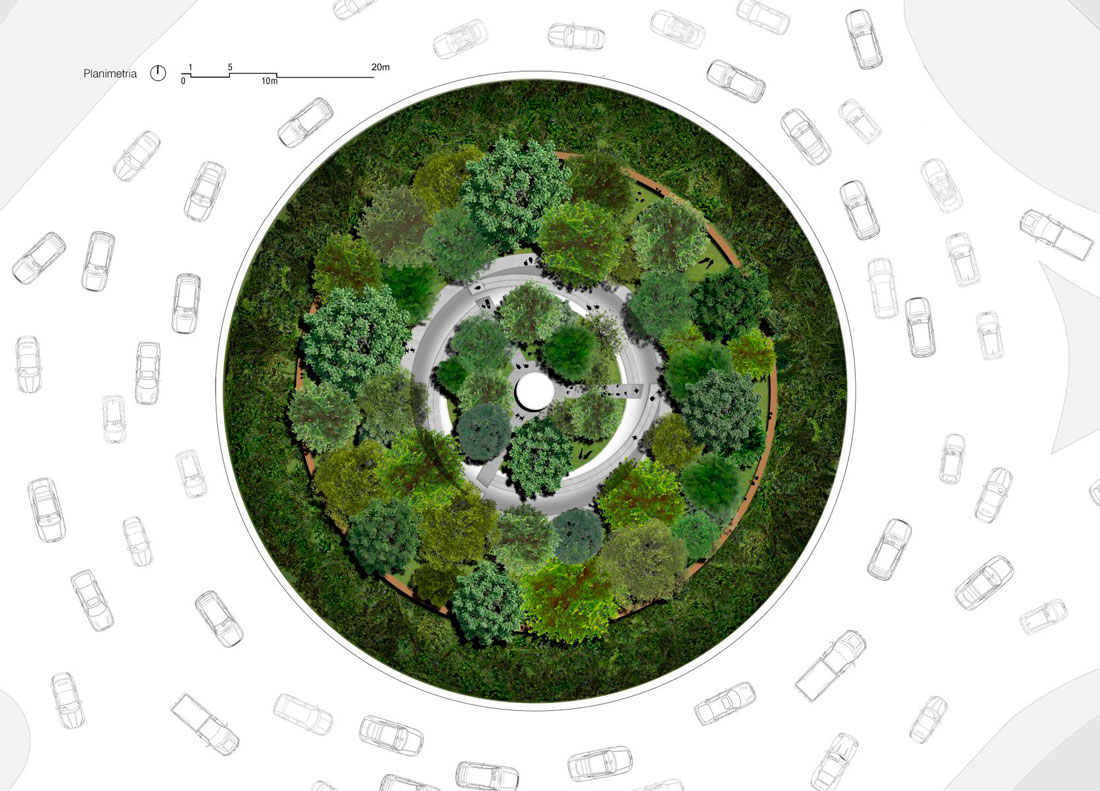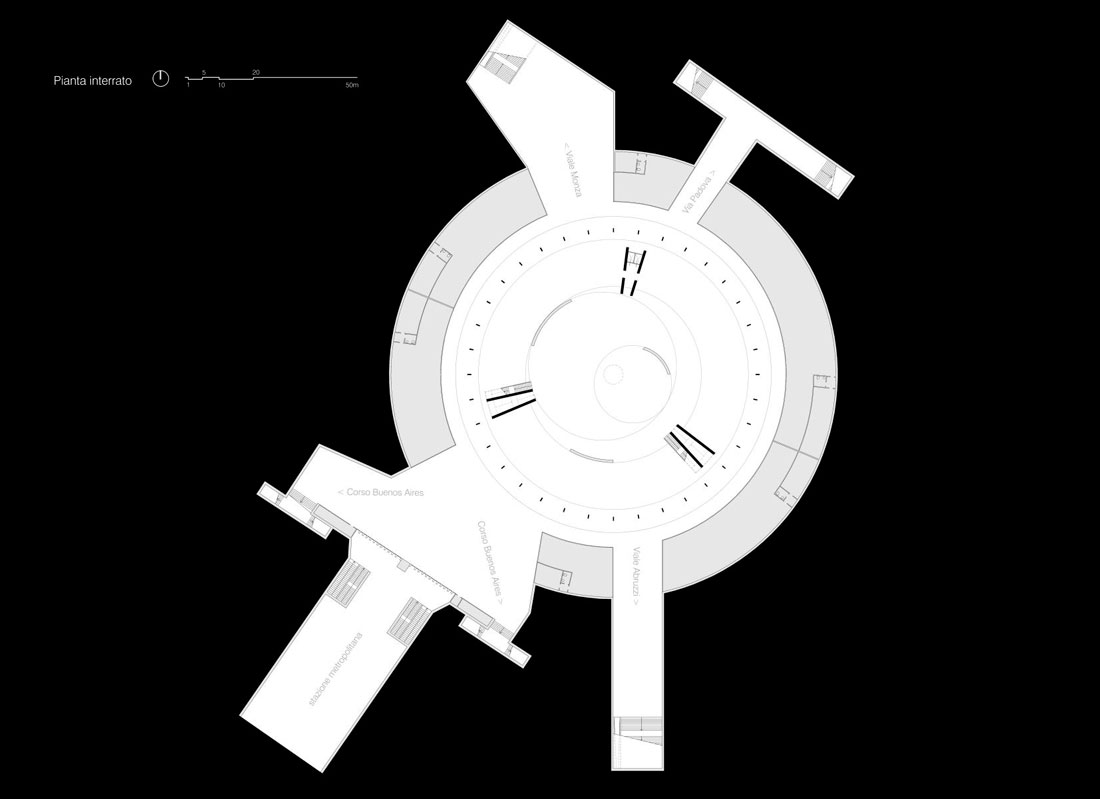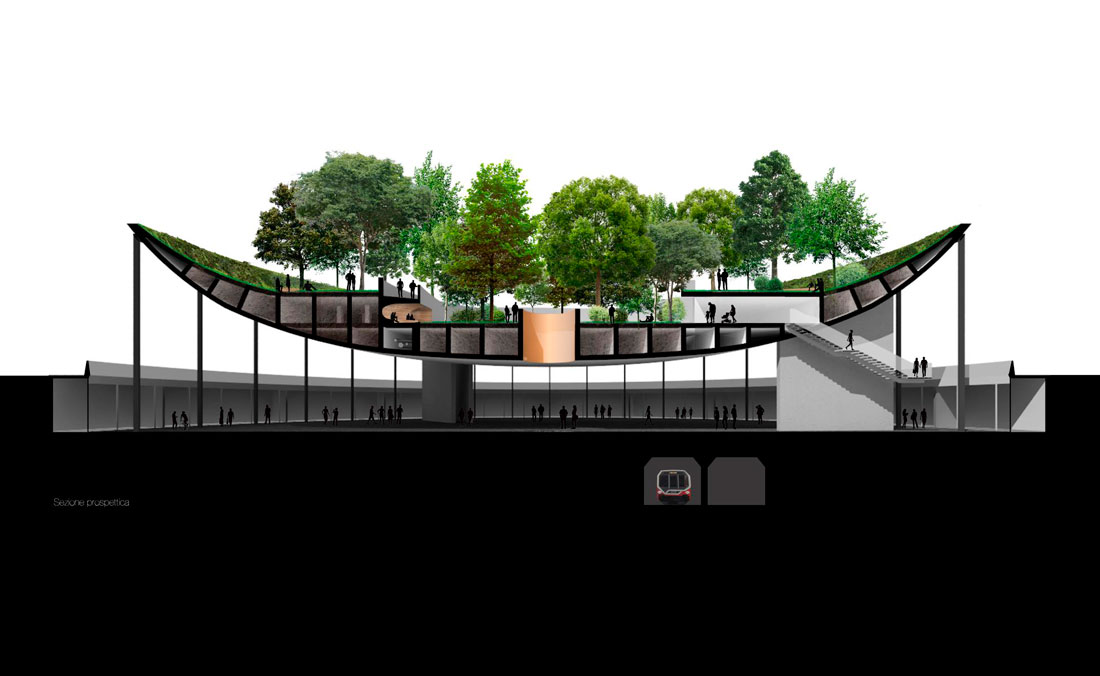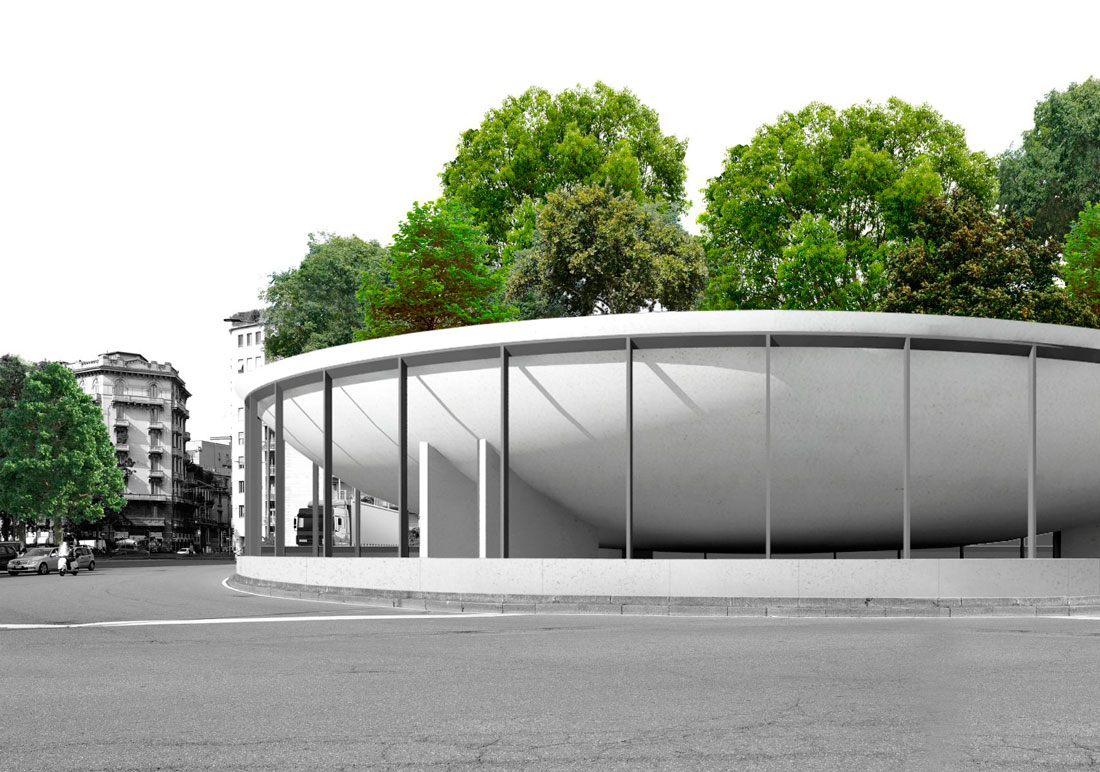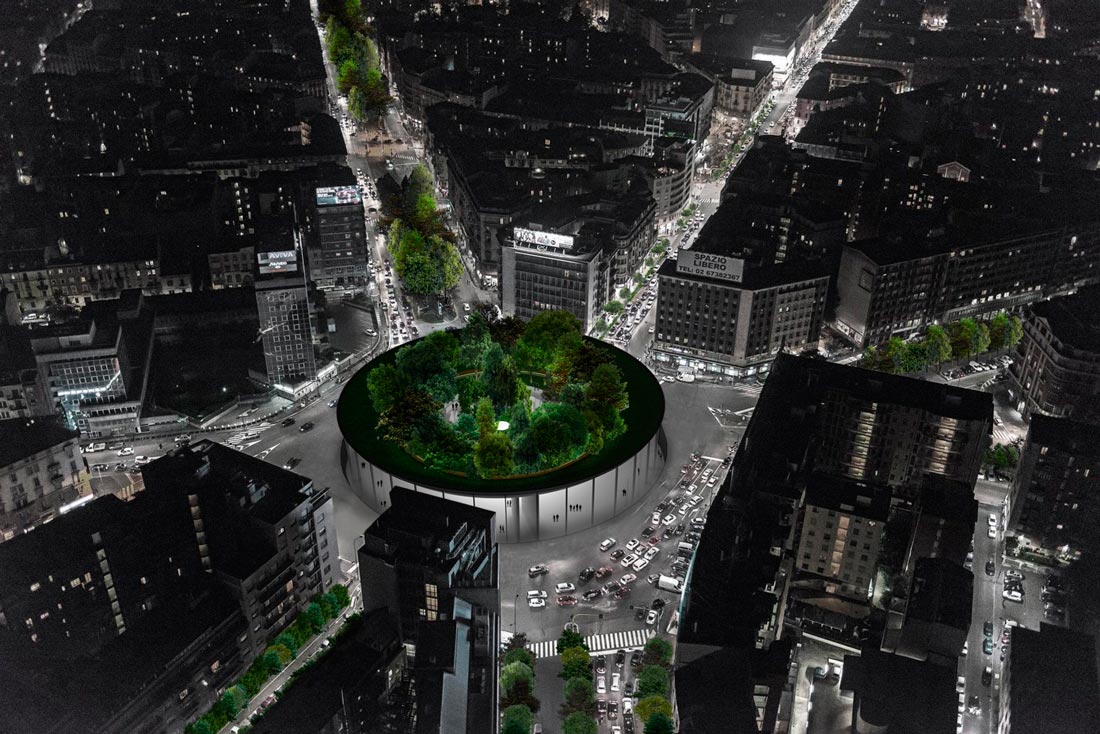The “Overpark” neologism identifies a green area built from scratch above a pre-existing urban function.
In the context of an urgent need for permeable soil and vegetation for our cities, it is faster to act by addition rather than by substitution.
In a city that create mezzanines inside its buildings, creating hanging public gardens is our urban regeneration strategy.
We applied the architectural concept of the Overpark in the context of Piazzale Loreto.
Piazzale Loreto is the gateway to Milan; some of the most fast-moving parts of the city gravitate around it.
Piazzale Loreto is a rather ugly place: nothing more than a roundabout surrounded by buildings without architectural value.
Unable to impose on the owners aesthetic upgrades of façades or renovations of the entire buildings, the project radically rethinks the central space to drive the conversion of what belongs to the private sector.
Premise
Expressing an opinion about the city – about the transformation of the city – through an architectural project can be considered a questionable operation, because urban planning should be the proper tool. Nevertheless, the clear distinction between these two tools can be debated and may appear dated, in some cases, in comparison to the problematics of a modern city, which is the result of continuous planning.
Therefore, whereas planning lays out what “needs to be done” and defines the rules for doing it, in our case an architectural project, ignoring those rules, unveils both what needs to be done and how to do it at the same time.
The outcome of our reflection is a project that was developed without a client assignment, without a call for tenders and without anyone having asked for it. This idea reflects our heartfelt need to regain the possibility of making public space better; it reflects the duty we feel, as architects, to design urban transformations and to place architectural design back at the center of the debate on the future of Italian cities.
The project deals with the renovation of Piazzale Loreto in Milan, through what we will call a “Sovraparco”, a suspended green area built from scratch above a pre-existing urban function.
The Idea
Piazzale Loreto is the entrance to Milan, around which some of the most dynamic neighborhoods in the city gravitate.
However, Piazzale Loreto is also a rather ugly place: nothing more than an automobile junction surrounded by buildings without any architectural value.
Without forcing owners to renovate façades or even rebuild entire buildings, this project radically rethinks the space of the central void.
The roundabout
Piazzale Loreto is now a shapeless space: the project is laid over the ancient rondò shape visible on a map in 1865, and it rethinks circulation as a big roundabout. The placing of a circle, in its formal perfection, restores a powerfully defined space, substituting the current shapeless void. That footprint is nothing more than the original shape of the square, as it was in 1865.
The roundabout was then demolished: events of the Second World War during 1944–45 left a violent mark on Piazzale Loreto, which was destined to become left behind by the city. A process of damnatio memoriae reached its apex with the demolition of the Hotel Titanus, a splendid example of Art Deco, which was substituted with a huge concrete, curtain wall building, whose planimetrical setting doesn’t create any dialog with street alignments.
After the great excavations for the underground in the early 1960s, Piazzale Loreto finally became nothing more than a road junction with shapeless islands, planted with a bamboo forest.
In our project, the power of the circumference takes over the void.
As in the famous examples of huge street roundabouts, above all the Champs-Élysées Étoile, vehicular traffic is channeled in a pure form, creating a certain aesthetic.
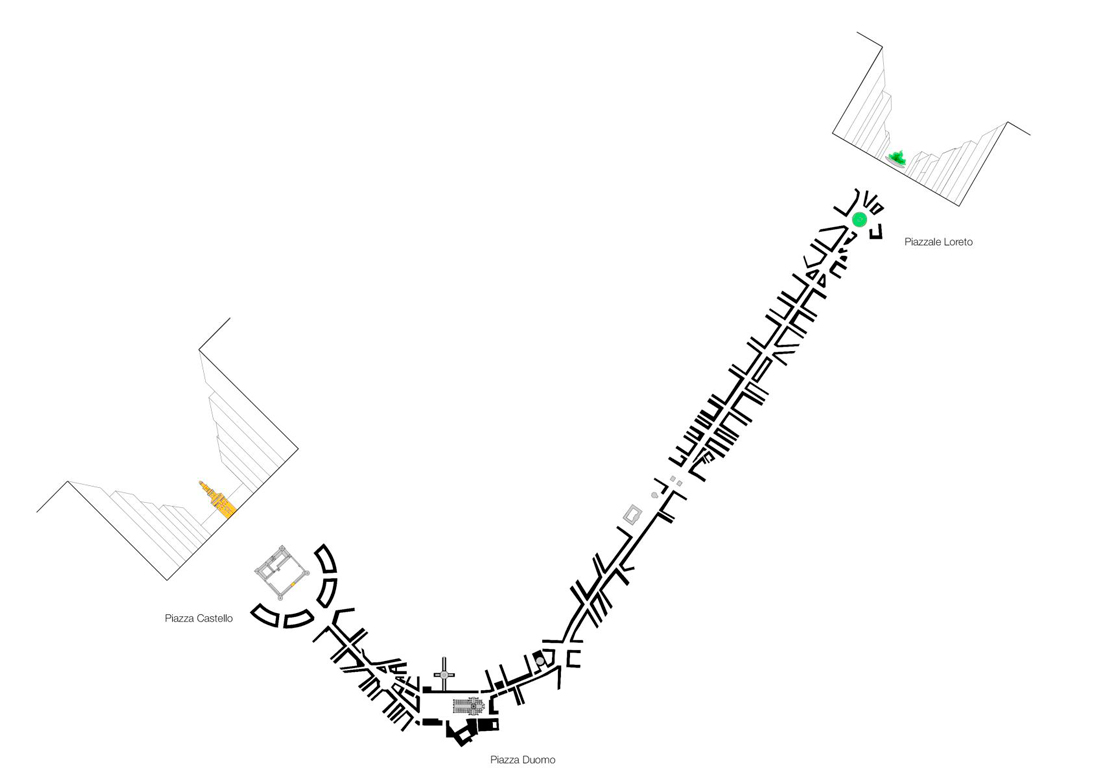
 The Underground Plaza
The Underground Plaza
Under the street level, there is an important junction of the Milan underground, though it never acquired the role of station. Enormous flows of people pass through it every day, restricted inside narrow tunnels. Uncovering the mezzanine level, we obtain a wide and airy plaza, capable of connecting parts of the city which today are closed off.
Beyond the underground access, the plaza is equipped with stores, coffee shops and restrooms.
The center of the plaza is deliberately rather empty: it is free and available to be used by citizens.
The Suspended Garden
As we said, the neologism “Sovraparco” (Elevated Garden) indicates a green area built from scratch on top of a pre-existing urban function.
In the urgent context of the need for permeable land and vegetation for our cities, it is quicker to add, rather than to substitute.
Like a planet hosting a natural oasis, the garden floats over the plaza; like a reversed shell, nothing is visible from the inside but the sky.
The borders protect people from pollution and traffic noise, generating a relative isolation inside, which has had success in many elevated parks in the World, from the Promenade Plantée in Paris to the High Line in New York City.
The access to the shell is possible through stairs and an elevator. Once inside the shell, the garden is organized across two flat levels. The first level hosts stairs and an elevator, as well as some services and covered spaces. In its center there is a large oculus, opening downwards toward the plaza underneath, which in a certain way reverses the spatial logic of the Pantheon in Rome; a ramp system leads to the second level of the garden.
In the Sovraparco garden it is possible to relax, read or even hold small parties, but the formal circular power never minimizes its monumental image.
Like the Filarete Tower, establishing spatial relationships both with the Castello Sforzesco and with the road that leads to the Duomo, our project aims to highlight Corso Buenos Aires as a focus of high symbolic value. The background of the most important commercial street in Milan should not be an abandoned building but a luxuriant park, an urban forest populated with plants, animals and human beings.
In synthesis, the park and the plaza are “public” spaces, but they also have the characteristic of being “free” spaces due to their access and their use. This connotation brings us closer in some way to what Yvonne Farrell and Shelley McNamara have called “freespace”, researched in their Biennale d’Architettura exposition in 2018.
LAD (Laboratory of Architecture and Design) and Hypnos, the authors, write:
“FREESPACE describes a generosity of spirit and a sense of humanity at the core of architecture’s agenda, focusing on the quality of space itself.
FREESPACE focuses on architecture’s ability to provide free and additional spatial gifts to those who use it and on its ability to address the unspoken wishes of strangers.
FREESPACE celebrates architecture’s capacity to find additional and unexpected generosity in each project – even within the most private, defensive, exclusive or commercially restricted conditions.
FREESPACE provides the opportunity to emphasize nature’s free gifts of light – sunlight and moonlight, air, gravity, materials – natural and man-made resources.
FREESPACE encourages reviewing ways of thinking, new ways of seeing the world, of inventing solutions where architecture provides for the well-being and dignity of each citizen of this fragile planet.”

